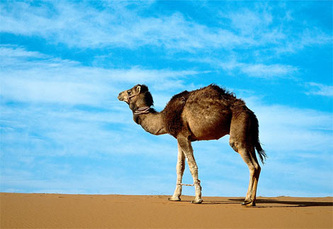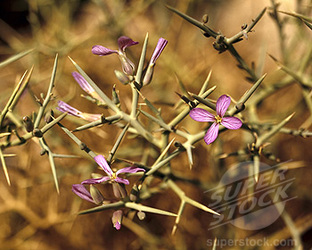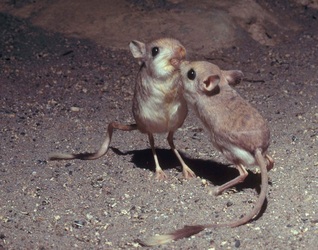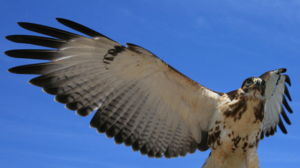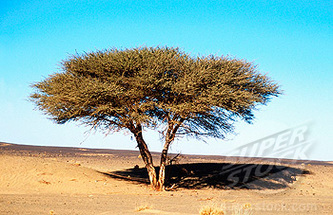Biome... What is it?
Biome is a major regional or global biotic community, such as a desert, in this case, and is characterized chiefly by the dominant forms of plant life and the prevailing climate conditions.
Where in the world is the Sahara Desert located?
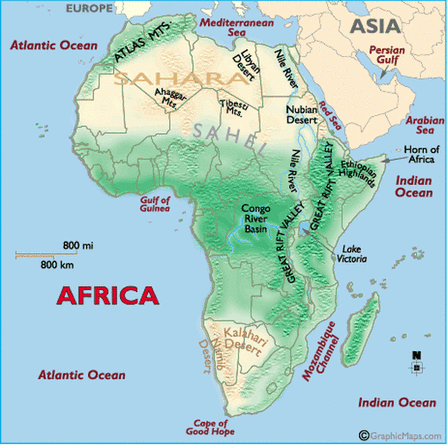
Sahara, the largest desert in the world, stretches across northern Africa. The Desert covers several African nations including Algeria, Chad, Egypt, Libya, Mali, Mauritania, Morocco, Niger, Sudan and Tunisia. Most of the Sahara Desert is undeveloped and features a varied topography. Most of its landscape have been shaped over time by wind and includes sand dunes, sand seas called ergs, barren stone plateaus, gravel plains, dry valleys and salt flats. The Sahara Desert is also a subtropical desert; the air is warmed at the equator and falls back to the ground as cool, dry air.
Hot Deserts around the world

Geographically speaking, Hot deserts can be located near the Equator, usually between latitudes 10 degrees and 30 degrees north or south. They are located near the center or west coasts of continents.
What is the climate of the Sahara?
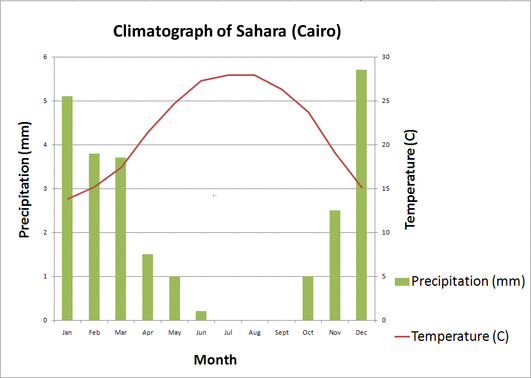
We created our own climatograph of the Sarah Desert, focusing on its location Cairo. It is extremely dry and hot, however, it is believed that the Desert has undergone various climatic shifts because of fluctuating precipitation rates, but precipitations is scare in this region. While the temperature of Sahara increases during the summer and decreases during the cold winter, the precipitation Sahara receives decreases during the summer and increases during the winter.
To its disadvantage, Sahara's climate is a prevailing limiting factor, especially effecting the flora and fauna. Because of its hot and extremely dry climate, there is almost no plant life with the exception of a few species of trees. Its harsh conditions takes its toll on the animal life, and the animals are forced to adapt to the Sahara's austere climate and extremely high temperature, and animals tend to have characteristics such as thick skin and underground life, and searching for food and water at night. In an area of the Sahara, called Erg, a large soft area of desert made up of dry and flat basins, hold neither forms of animal life nor plants. With the mention of the Erg, another major limiting factor is the landform, which are largely flat and sandy; there is a great absence of landform and cannot support a sufficient amount of animal life.
To its disadvantage, Sahara's climate is a prevailing limiting factor, especially effecting the flora and fauna. Because of its hot and extremely dry climate, there is almost no plant life with the exception of a few species of trees. Its harsh conditions takes its toll on the animal life, and the animals are forced to adapt to the Sahara's austere climate and extremely high temperature, and animals tend to have characteristics such as thick skin and underground life, and searching for food and water at night. In an area of the Sahara, called Erg, a large soft area of desert made up of dry and flat basins, hold neither forms of animal life nor plants. With the mention of the Erg, another major limiting factor is the landform, which are largely flat and sandy; there is a great absence of landform and cannot support a sufficient amount of animal life.
Definitions relating to Productivity
- gross productivity- Gross productivity is the total output of energy produced by an entire ecosystem, and in desert biomes such as the Sahara, it is very low.
- net productivity- Net productivity is the the gross productivity minus the respiration and waste products of the entire ecosystem. There is a low carbon dioxide release in deserts.
- primary productivity- primary productivity is the rate at which producers (plants) convert energy from the sun into chemical energy; desert plants lack an efficient amount of photosynthesis, therefore less carbon dioxide is produced.
- secondary productivity- Secondary productivity is the rate at which consumers transfer energy from plants into their own energy and biomass
- gross primary productivity- Gross primary productivity is the total rate of photosynthetic material produced, and this rate is low in desert biomes.
- net primary productivity- Net primary productivity is the gross primary productivity minus the respiration by the plants.
How does the Food Web look like?
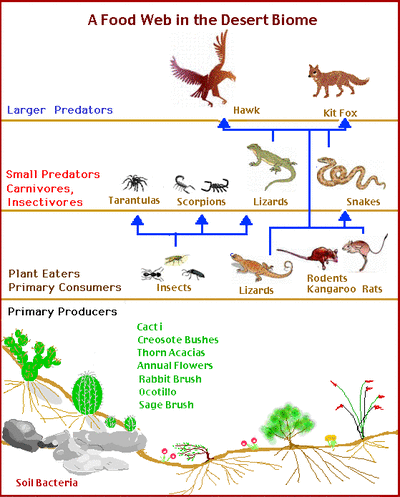
Due to the high temperatures and arid conditions of the Sahara Desert, the plant life in the Sahara Desert is sparse, and the Sahara consists of about 500 species of flora. At some oases, olive trees can be found. However, these consist mainly of drought and heat resistant varieties and those adapted to salty conditions (halophytes) where there is sufficient moisture.
Some primary producers are date palm, acacias, cacti, various brush, tamarisk, rubber trees, spiky trees, sodome apple trees, zilla, and wildflowers. Consumers include gerbils, cape hare, weasels, jackals, lizards and small insects. Decomposers found in the Sahara are soil bacteria, fauna, fungi, and mushrooms. Carnivores in the Sahara are sand cats, foxes, even the sidewinder snake, striped hyenas, hawks, and eagles, which are considered as the top carnivores in the desert food web. Herbivores include the desert jerboa, mounflon(wild sheep), Dorcus gazelle, and the Arabian camel.
The Sahara is home to many endangered species of fauna; Addax Antelopes, Sahara Cheetah, Sahara Wolf, Dama Gazelle. The screwhorn antelope is threatened by hunting and habitat loss, and the remaining number is less than 300. Slender horned gazelles' population is slowly declining, also.
The first trophic level includes the primary producers such as shrubs, cactus, and wildflowers. Limited by the availability of water, they produce fewer than 200 Kilocalories of food for the animals for each square meter each year.
The second level consists of small animals that consume small amounts, which are herbivores and mostly reptiles and insects. As food for predators, they provide about 20 Kilocalories per square meter per year for predators
The third level includes predators that are the secondary consumers such as snakes, and insect-eating lizards. In the harsher desert environments, they are the top predators. Only about 2 Kilocalories per square meter per year are stored in their bodies. In the harsher desert environments, they are the top predators. Finally, the fourth level includes high level consumers, carnivores that will eat other carnivores.
Some primary producers are date palm, acacias, cacti, various brush, tamarisk, rubber trees, spiky trees, sodome apple trees, zilla, and wildflowers. Consumers include gerbils, cape hare, weasels, jackals, lizards and small insects. Decomposers found in the Sahara are soil bacteria, fauna, fungi, and mushrooms. Carnivores in the Sahara are sand cats, foxes, even the sidewinder snake, striped hyenas, hawks, and eagles, which are considered as the top carnivores in the desert food web. Herbivores include the desert jerboa, mounflon(wild sheep), Dorcus gazelle, and the Arabian camel.
The Sahara is home to many endangered species of fauna; Addax Antelopes, Sahara Cheetah, Sahara Wolf, Dama Gazelle. The screwhorn antelope is threatened by hunting and habitat loss, and the remaining number is less than 300. Slender horned gazelles' population is slowly declining, also.
The first trophic level includes the primary producers such as shrubs, cactus, and wildflowers. Limited by the availability of water, they produce fewer than 200 Kilocalories of food for the animals for each square meter each year.
The second level consists of small animals that consume small amounts, which are herbivores and mostly reptiles and insects. As food for predators, they provide about 20 Kilocalories per square meter per year for predators
The third level includes predators that are the secondary consumers such as snakes, and insect-eating lizards. In the harsher desert environments, they are the top predators. Only about 2 Kilocalories per square meter per year are stored in their bodies. In the harsher desert environments, they are the top predators. Finally, the fourth level includes high level consumers, carnivores that will eat other carnivores.
Primary Productivity
In terms of productivity of biomes, desert biomes have the lowest productivity. It is cumbersome for plants to thrive in a biome like the Sahara, simply because the soil consists a high level of saline; the soil water will be too salty for plants. Moreover, the blatant problem is the lack of water and the sporadic rainfalls will be quickly run off or evaporated by the harsh sunlight. As a result of this, growth in desert plants is extremely slow.
Soil Composition
The Sahara consists of one quarter volcanic mountains, one quarter sand, rocks, gravel covered plains, and small areas of vast permanent vegetation. The Sahara Desert has about 200,000 square kilometers of fertile soil, owing to the fact that the land in these areas is constantly fed by underground rivers, reservoirs or artisan wells. The prevailing wind blows across land so it does not carry much moisture. The soil is low in humus and is mostly saline in low lying areas. As a result, plant growth is sparse. The problem is compounded by the severely dry weather which causes desiccation of plants due to high rate of transpiration and evaporation of water from the leaves. Since plant growth is sparse and water is scarce, Saharan plants and trees have adapted to its severely dry climate to reduce evaporation and increase water absorption; small leaves, very long roots that can reach the most humid layers of soil (acacias, tamarisks), lose their leaves when it is arid and make them grow when it is humid (zilla), and some plants even made their leaves uneatable. However, some of the plants are well adjusted to the climate since they sprout within three days of rain and sow their seeds within two weeks after that.
